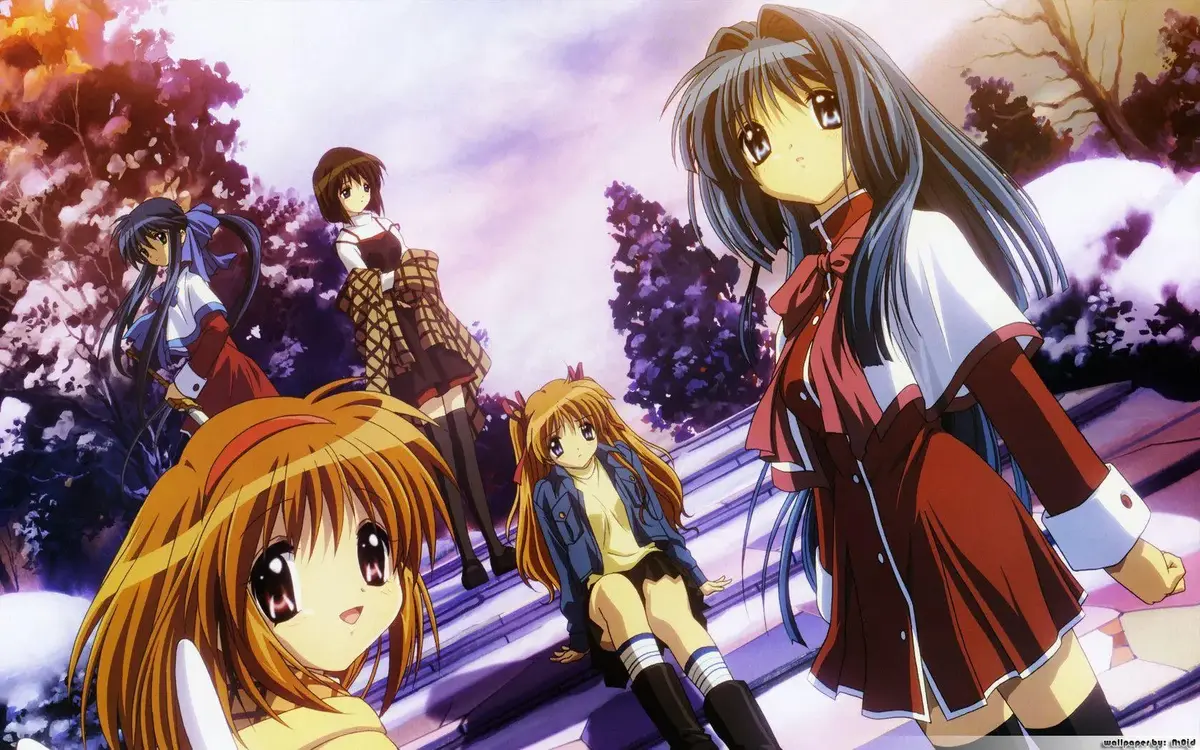A Studio Unlike Any Other
Among all Japanese animation studios, Kyoto Animation (or KyoAni) holds a unique place. Founded in 1985 in Uji, near Kyoto, it built its reputation slowly, going against the dominant industrial trends. While others focused on quantity or market trends, KyoAni consistently chose refinement, quality, and an intimate connection with its narratives.

Emotional Storytelling and Breakthrough Success
The studio first gained recognition in the 2000s with adaptations of Key’s works (Air, Kanon, Clannad), showcasing its sensitivity for emotional dramas with nuanced characters. Then came The Melancholy of Haruhi Suzumiya, a cultural phenomenon that propelled Kyoto Animation into the spotlight.
A Unique Production Model
From the beginning, the studio stood out with its unique internal structure. Unlike most of the industry, it trains animators in-house, offers stable contracts, and limits outsourcing. This rare model has contributed to the consistent quality of its productions.
Visual Mastery and Subtle Storytelling
Visually, Kyoto Animation is known for its smooth animation, meticulous attention to everyday details, and naturalistic movements. The simplest gestures—a clenched hand, a hesitant glance, a shiver in the hair—become moments of silent storytelling.

Human Stories and Emotional Depth
But KyoAni isn’t just about visuals. Its storytelling thrives on restrained emotion, character development, and meaningful silences. In Violet Evergarden, the inner transformation of a former child soldier becomes a quest for meaning, carried by sensitive writing and poetic direction.
Avoiding loud or exaggerated plots, the studio favors human stories, often centered on young girls, exploring fragility, healing, or emotional awakening. Even in lighter works like Tamako Market, there’s a tenderness for everyday life.
Original Works and Creative Vision
Kyoto Animation has also ventured into original productions like Free!, Sound! Euphonium, and Beyond the Boundary, crafting rich, coherent worlds—sometimes rooted in realism, sometimes tinged with melancholic fantasy.

A Legacy of Resilience
The tragic arson attack in July 2019, which claimed 36 lives, shook the industry but also revealed the deep affection fans hold for KyoAni. The studio returned with powerful projects like Violet Evergarden: The Movie, a masterpiece of resilience and elegance.
Pioneering Representation and Artistic Integrity
The studio has been a pioneer in sensitively portraying female relationships without caricature. Works like Liz and the Blue Bird explore adolescent friendships with rare delicacy.
Conclusion : A Unique Voice in Anime
Kyoto Animation isn’t just a studio—it’s an ethical creative space, an artistic signature, and a unique voice in modern anime. It reminds us that the most beautiful stories often emerge from quiet moments and that animation can be an art of restrained emotion.
Kyoto Animation – The Quiet Revolution of Japanese Anime
Table of Contents
A Studio Unlike Any Other
Among all Japanese animation studios, Kyoto Animation (or KyoAni) holds a unique place. Founded in 1985 in Uji, near Kyoto, it built its reputation slowly, going against the dominant industrial trends. While others focused on quantity or market trends, KyoAni consistently chose refinement, quality, and an intimate connection with its narratives.
Emotional Storytelling and Breakthrough Success
The studio first gained recognition in the 2000s with adaptations of Key’s works (Air, Kanon, Clannad), showcasing its sensitivity for emotional dramas with nuanced characters. Then came The Melancholy of Haruhi Suzumiya, a cultural phenomenon that propelled Kyoto Animation into the spotlight.
A Unique Production Model
From the beginning, the studio stood out with its unique internal structure. Unlike most of the industry, it trains animators in-house, offers stable contracts, and limits outsourcing. This rare model has contributed to the consistent quality of its productions.
Visual Mastery and Subtle Storytelling
Visually, Kyoto Animation is known for its smooth animation, meticulous attention to everyday details, and naturalistic movements. The simplest gestures—a clenched hand, a hesitant glance, a shiver in the hair—become moments of silent storytelling.
Human Stories and Emotional Depth
But KyoAni isn’t just about visuals. Its storytelling thrives on restrained emotion, character development, and meaningful silences. In Violet Evergarden, the inner transformation of a former child soldier becomes a quest for meaning, carried by sensitive writing and poetic direction.
Avoiding loud or exaggerated plots, the studio favors human stories, often centered on young girls, exploring fragility, healing, or emotional awakening. Even in lighter works like Tamako Market, there’s a tenderness for everyday life.
Original Works and Creative Vision
Kyoto Animation has also ventured into original productions like Free!, Sound! Euphonium, and Beyond the Boundary, crafting rich, coherent worlds—sometimes rooted in realism, sometimes tinged with melancholic fantasy.
A Legacy of Resilience
The tragic arson attack in July 2019, which claimed 36 lives, shook the industry but also revealed the deep affection fans hold for KyoAni. The studio returned with powerful projects like Violet Evergarden: The Movie, a masterpiece of resilience and elegance.
Pioneering Representation and Artistic Integrity
The studio has been a pioneer in sensitively portraying female relationships without caricature. Works like Liz and the Blue Bird explore adolescent friendships with rare delicacy.
Conclusion : A Unique Voice in Anime
Kyoto Animation isn’t just a studio—it’s an ethical creative space, an artistic signature, and a unique voice in modern anime. It reminds us that the most beautiful stories often emerge from quiet moments and that animation can be an art of restrained emotion.